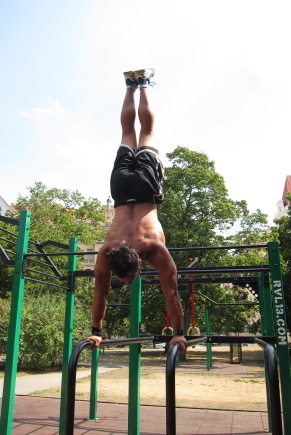So beautiful, so complex, so difficult to develop without the prior gymnastics background, so many details, so many atoms integrated into one molecule, so much work. – Ido Portal
‘The stalder press is a bi-phasic, dynamic movement’, blending together a high straddle hold (or straddle l-sit) through to a half press movement, finishing with a straddle press handstand. To see a skill of such beauty performed is a true testament to the levels of active and passive flexibility, strength, mobility, coordination, proprioception and countless other elements worked for and achieved by it’s performer.
And one day it will be mine! Muahaha! But not yet… not yet…
Throughout this 2-part post I will break-down where I am now with this movement, and where I think I need to go. For an introduction to the progressional elements of the stalder press Ido Portal provides a great breakdown in this Facebook post from 2013, and of course the internet is always a great sea of information (unless you let it drown you).
A Generous Quarter.
So my stalder press… is not yet a stalder press. I am, however, confident that I have perhaps one-and-a-quarter of the elements in place. That’s if we’re counting the hold and press equally as in a 1:1 ratio; and that’s me giving a generous quarter.
This recent video from June 2016 shows the general state of my straddle press handstand (we might generously say 50% of the full stalder press).
I am currently performing this movement for 3-4 reps each set, and I am happy with this progress since the beginning of my handstand press journey in 2013. So that’s the ‘one’ in place…
As for the generous quarter… I could also call it a ‘quarter guessed’. It refers to pushing through the half-press motion, and it is ‘guessed’ because I am currently able to perform this movement from an elevated straight-leg l-sit. This is, however, quite a different starting position to to a straddle l-sit and I am only ‘guessing’ that that this strength element will carry-over into the straddle version required for the stalder. These next few videos show my progression in the straight-leg l-sit to handstand press (there must be a shorter name for the movement out there…) since 2013, on both parallels and open-handed holds:
One of my first times achieving this move back in July 2014. It’s shakey and somewhat unsightly, but at the time gave me a great boost in confidence to be able to perform as I hadn’t actually been training for it. It just seemed to come together after training a lot of pressing from the floor and regular static l-sit work. Issues with my form are pretty glaring and you can find a brief critique in the YouTube video write-up.
Prague, August 2015. My first attempt of this move on the high bars. I think the press
is shakey mostly because of my nerves, but also my hold just isn’t that great yet.
Also the bars are slightly wider than the low parallels I usually used so it felt a bit unfamiliar. An attempt at a HS pushup at the end, unnecessary really but couldn’t help it… Also my natural instinct at this time is to go into a straddle for the pushup attempt because it basically felt easier.
One month after building the confidence to try this move on high bars, I found myself at it again on this wooden horse in South Korea, where I had moved that month. I remember feeling a lot more confident in the press than in Prague the month before, and I maintained the feet-together position in attempting the HS pushup, which I feel is a harder position than a straddle. Nevertheless the HS pushup is again clearly a fail, banana-ing out of control to a clumsy descent, although I did feel the strength and control to go lower in the negative. I’ll be leaving this ‘tack-on’ handstand pushup until I’ve actually got them locked down from the floor with no banana – it doesn’t move me toward my goal.
The Weakest Link
This first part has introduced where I feel I am now looking forward to approaching training for the stalder press, namely my (uneducated) hope that my l-sit to press will somehow translate to a straddle l-sit to press… So in part 2 I’ll introduce what I think is the real challenge, the other ‘50%’ which really will be slow and steady progress requiring consistent and progressive training. And as with so many movements which express the limits of one’s ability, it’s one that lies along the grinding road of mobility (or my lack, thereof). Until then, pancake… pancake… pancake…

Leave a comment